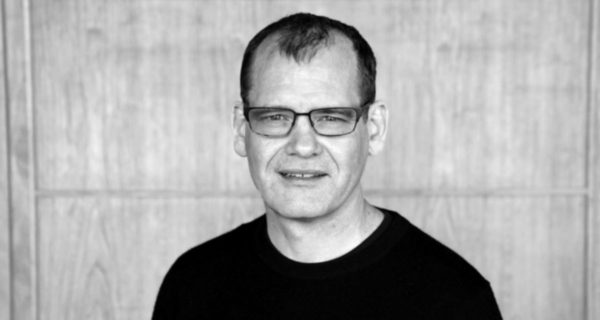A long-time collaborator and renowned expert in Buddhist philosophy and contemplative studies, John Dunne joins the Center for Healthy Minds as a new faculty member and professor of East Asian Language and Literature, bringing religious and historical perspectives to further our understanding of the mind and well-being.

You’re no stranger to the Center. What early projects did you work on with Center Founder Richard Davidson?
Richie and I hit it off, and he asked if I would come to the lab and just visit. When I got there, part of what really intrigued me about some of those early visits was working with people like Buddhist monk Matthieu Ricard and Mingyur Rinpoche, the Tibetan Lama. It was a puzzle of trying to understand some very specific features of contemplative practices in ways that from the Buddhist perspective, we don’t quite think about them, especially from a behavioral perspective.
We began studying something well-known in psychology called the “startle response,” or a person’s reaction to an unexpected stimulus such as a burst of air to the face. We wanted to learn whether these meditators had the same response as people who don’t meditate, or if they would show something else. Those empirical questions gave me a totally new window into understanding Buddhist practices.
The excitement and the curiosity of looking at the practices in this new, fresh way made our collaboration incredibly fruitful. And one of the great things about empirical research is you always get some kind of answer to your questions, even if the answer is just, “You’re confused!”
You try it out, and even when you discover that you’re wrong, there are great opportunities for learning. That’s a key feature of science, and that’s what helps us understand how those practices are operating. In the very early days, everyone would sit around a table just trying to puzzle through some basic questions, mostly in English, but sometimes in Tibetan. It felt like we were uncovering new territory – “Going where no one has gone before,” as they say in Star Trek.
"One of the obstacles in the study of meditation practices is the assumption that they’re all the same."
What are the advantages of studying the impact of contemplative practices from a Buddhist tradition specifically?
People practicing often experience the same protocol in principle. There can be a lot of variation, even within traditions, but if you’re careful enough, you’re going to find practitioners are engaged in very similar practices. And that’s important, especially in science when you want to standardize and exclude interfering factors. One of the obstacles in the study of meditation practices is the assumption that they’re all the same. So scientific publications, until pretty recently, did not specify exactly which practice they were talking about. Today, we’re beginning to speak about meditation practices in the plural, and not assume that we’re studying “meditation,” as if all practices were the same.
The term “mindfulness” has gone mainstream, and some have joked about its popularity, labeling it “McMindulness.” How does the entire history of contemplative practice play into the conversation?
The Center has clinical interests in using contemplative practices as interventions for mental health, and there’s a history of the use of meditation practices and contemplative practices in a kind of clinical way by Buddhists. So for example, one of the things that’s not often known is that Buddhists have styles of meditation targeted at specific kinds of psychological issues. If you have a problem with anger, there’s certain kinds of meditation, for example meditation on loving-kindness, you would do. If you have an issue with too much attachment, then there are meditations that are designed specifically to reduce attachment. If you have a problem with thinking too much, then there are styles of meditation that are designed to reduce rampant thought, most especially mindfulness of breathing.

How can the humanities play a role in the Center’s research and the science of well-being at-large?
Scholars from the humanities who look at contemplative practices can understand the way in which traditions may try to present their practices in the best possible light. And in doing so, they may be sort of camouflaging some issues, or they may be suggesting a degree of unity that on the ground isn’t the case. One issue is the way we use texts. We sometimes think that when we want to understand a contemplative practice like meditation, that our best way to do that is to go to an old Buddhist text. We may believe that by simply reading that ancient text, we will understand what the contemplative practice is and how it works. But actually it’s much more complex. That text certainly has a role to play in our understanding of the practice, but we also need to see what people actually do on the ground.
We need to ask key questions – What instructions were given? How do practitioners interpret those instructions? What role do institutions like monasteries or retreat centers play to support practices, and how are those institutions run? These factors can have a huge effect on the way the practices are actually realized. So part of what a humanities scholar can do is help us to avoid simply turning to books for understanding practices, and instead look at the practices on the ground.
In your journey to more fully understand the mind, what excites you the most about working more collaboratively across disciplines?
What excites me the most is actually developing the capacity for this research by creating teams and so on. Right now, a key challenge is to create the right kind of research teams to explore contemplative practices. That challenge is really exciting because it compels us to be creative and interdisciplinary. Of course, there’s also a lot of excitement about just exploring all of the practices: How do they work? What are their effects? How are they beneficial? What can we adapt or learn from contemplative practices that can be helpful for wellness or in therapeutic contexts? But a lot of the excitement is actually figuring out how we’re going to do that.
In a sense, we’re about to set off on a big adventure, and we’re at that point where we’re all in the tavern and we’re getting all our equipment together and figuring out who’s going to go with us. And that’s a really powerful moment because what we’re really determining is what’s our method – how can we best explore the vast world of contemplation?
Interview conducted and edited by Marianne Spoon






